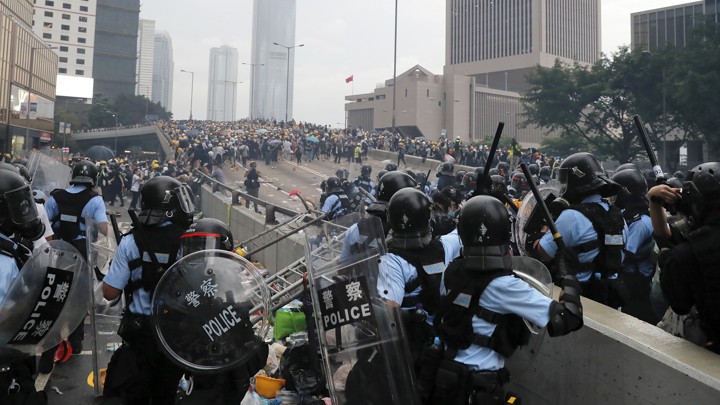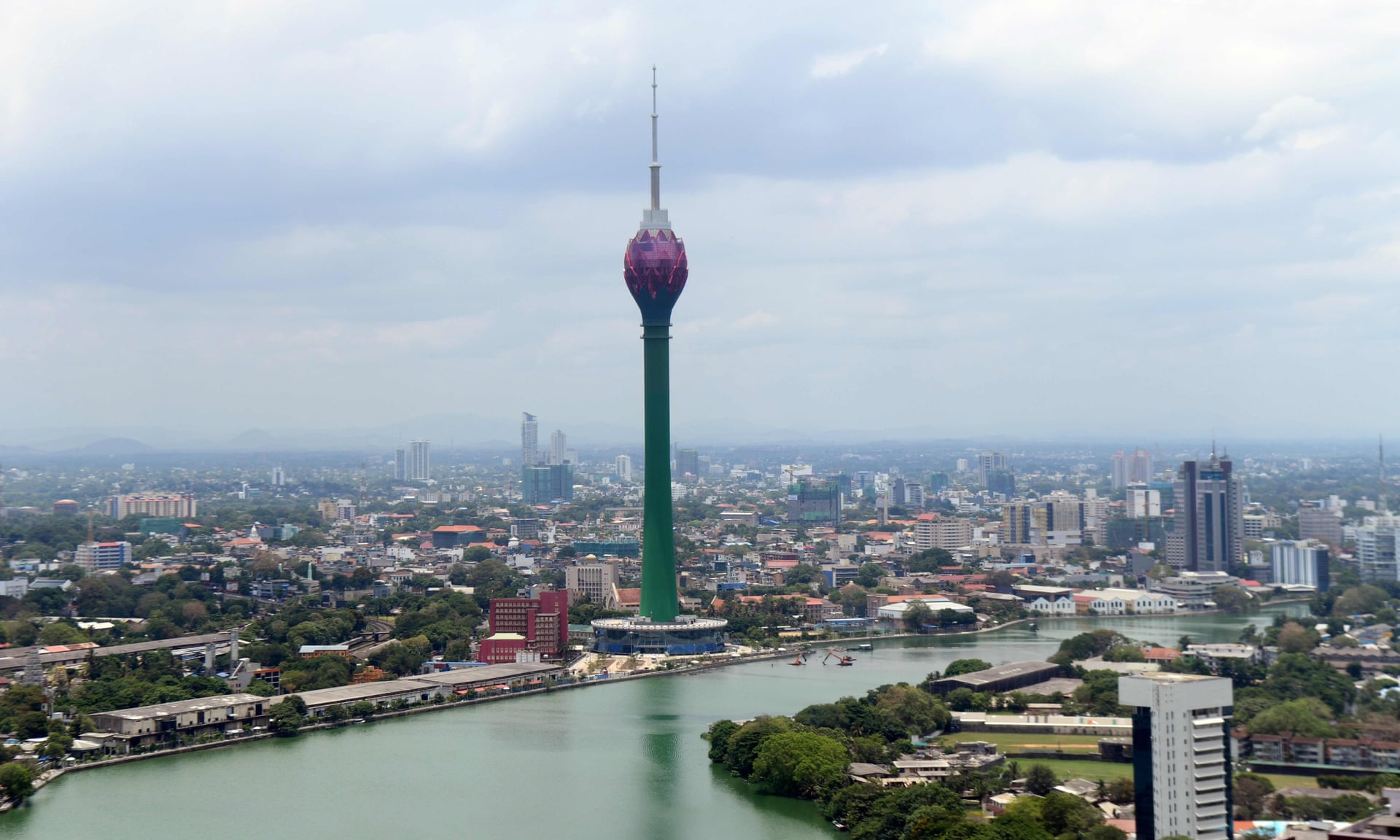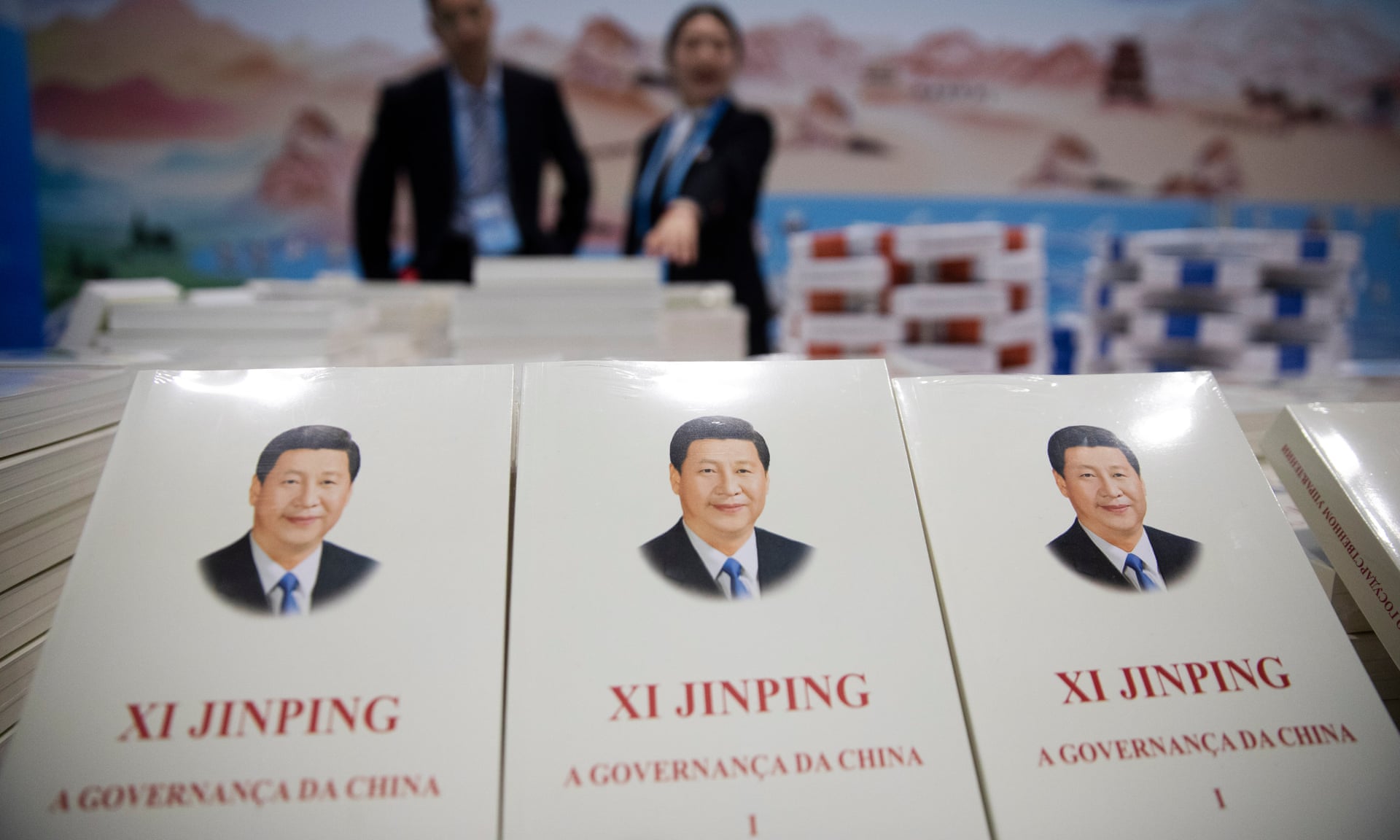By JEFFREY WASSERSTROM
 Riot police prepare to throw tear gas at protesters in Hong Kong.
Riot police prepare to throw tear gas at protesters in Hong Kong.
The Beijing massacre was not the only important thing that happened in the world on June 4, 1989.
To be sure, the news dominated the front page of the following day’s edition of The New York Times—“Beijing Death Toll at Least 300” ran across the top, accompanied by a photograph of bloodied bodies and crushed bicycles.
 Riot police prepare to throw tear gas at protesters in Hong Kong.
Riot police prepare to throw tear gas at protesters in Hong Kong.The Beijing massacre was not the only important thing that happened in the world on June 4, 1989.
To be sure, the news dominated the front page of the following day’s edition of The New York Times—“Beijing Death Toll at Least 300” ran across the top, accompanied by a photograph of bloodied bodies and crushed bicycles.
Below that image, however, was a story bearing the headline “Big Solidarity Victory Seen in Poland,” illustrated with a photograph of Lech Wałęsa, the dock worker turned political prisoner who against all odds was about to ascend to national power.
Oh, and Iran had named a new supreme religious leader.
As eventful as that early June was, for most members of the crowd I joined at Hong Kong’s Victoria Park this month for a candlelight vigil to honor the 30th anniversary of Tiananmen, only one thing that happened in late spring of 1989 seemed important.
As eventful as that early June was, for most members of the crowd I joined at Hong Kong’s Victoria Park this month for a candlelight vigil to honor the 30th anniversary of Tiananmen, only one thing that happened in late spring of 1989 seemed important.
The iconic Tank Man image seemed to be everywhere, on T-shirts and banners, and even turned into commemorative figurines.
Yet in spite of the powerful place Tiananmen holds in the imaginations of many Hong Kong residents, I am convinced that local activists would do well to keep in mind another thing that happened on June 4, 1989.
Yet in spite of the powerful place Tiananmen holds in the imaginations of many Hong Kong residents, I am convinced that local activists would do well to keep in mind another thing that happened on June 4, 1989.
At a time when a dramatic struggle over the city’s future is under way, centering on a proposed extradition law that large numbers of Hong Kong residents fear would sound the death knell for their ability to enjoy legal protections lacking on the mainland, the Tiananmen tragedy is worth remembering.
So, too, though, is the unlikely victory of Solidarity.
The value of drawing connections between Beijing in 1989 and Hong Kong’s recent struggles is obvious: It was a key moment of political awakening, and last weekend’s march has been described as the biggest held in Hong Kong since one staged 30 years earlier to express anger at the June 4th massacre.
The value of drawing connections between Beijing in 1989 and Hong Kong’s recent struggles is obvious: It was a key moment of political awakening, and last weekend’s march has been described as the biggest held in Hong Kong since one staged 30 years earlier to express anger at the June 4th massacre.
To some protest leaders in Hong Kong, such as Joshua Wong, their Umbrella Movement—the name for demonstrations that erupted in 2014—carried forward a tradition that can be traced back all the way to student rallies in 1919 and was revived in 1989.
What, then—given how much further in geography and culture Hong Kong is from Warsaw than it is from Beijing—is the point of looking back to Solidarity?
For one, there are some parallels associated with the protesters themselves.
What, then—given how much further in geography and culture Hong Kong is from Warsaw than it is from Beijing—is the point of looking back to Solidarity?
For one, there are some parallels associated with the protesters themselves.
For example, religious beliefs and organizations did not play a central role in the Tiananmen struggle, but Wong sometimes describes his activism as rooted in his faith.
One of the most important senior figures in the Umbrella Movement was Reverend Chu Yiu-ming, and Christian organizations have played significant roles in various recent Hong Kong struggles. These things all call to mind, despite important differences, the central role the Catholic Church played in Solidarity.
Another connection has to do with targets of protest.
Another connection has to do with targets of protest.
The people Solidarity challenged and ultimately bested were power-holders who claimed to be serving local people but were actually beholden to, and backed by the might of, a distant capital.
This description does not fit the leaders that the Tiananmen protesters challenged, but it does apply to Hong Kong Chief Executive Carrie Lam—and in this case, the distant capital is Beijing rather than Moscow.
Looking back to Solidarity’s electoral victory is certainly a more hopeful thing to do than focusing on the time that soldiers killed civilians in Beijing.
Looking back to Solidarity’s electoral victory is certainly a more hopeful thing to do than focusing on the time that soldiers killed civilians in Beijing.
It is worth remembering, though, that Solidarity’s fortunes were tied to developments in the Soviet Union as well as in Poland, and that its rise went in tandem with Mikhail Gorbachev’s softening of Moscow’s line toward states operating in its shadow.
Standing in Victoria Park on June 4, holding up a candle, I felt transported by a sense of being in step with a giant crowd engaged in a collective activity.
Standing in Victoria Park on June 4, holding up a candle, I felt transported by a sense of being in step with a giant crowd engaged in a collective activity.
Adam Michnik
As I let my mind wander, though, I began thinking more about Adam Michnik, a journalist who played key roles in the Solidarity story, than about the Tank Man.
He was on my mind in part because of a conversation we had early in the 2000s, when I was teaching at Indiana University and we hosted him for a visit.
He was on my mind in part because of a conversation we had early in the 2000s, when I was teaching at Indiana University and we hosted him for a visit.
He had just seen a documentary about Tiananmen, The Gate of Heavenly Peace, for which I had been a consultant.
When I asked him what he thought of it, he replied: “I knew everyone in the film.”
This was not to say that he had a lot of Chinese friends—as he watched the movie, he kept thinking of counterparts within Solidarity and felt a shock of familiarity hearing Tiananmen activists debate, just as he and his colleagues had, the relative value of different strategies for challenging authoritarian rule, some urging caution and others pushing for more radical actions.
Would Michnik feel the same way at Hong Kong mass actions like the one I attended?
Would he think he “knew everyone” at the scene?
Many of the protest leaders in Hong Kong have similarities with Michnik.
Many of the protest leaders in Hong Kong have similarities with Michnik.
As Nina Witoszek relates in her book The Origins of Anti-Authoritarianism, Michnik began his career as an activist by forming a study society at the tender age of 15.
Wong, who was similarly in his mid-teens in 2012 when he helped lead a successful drive to block the Hong Kong government from bringing mainland-style patriotic education into the territory, was, Witoszek concluded, a “living alter ego” of Michnik—each had even fallen afoul of a Communist Party and spent time behind bars as a prisoner of conscience. (Wong was, in fact, serving his second stint in jail at the time of the recent Victoria Park vigil.)
There are other, perhaps even more apt, successors to Michnik in the city, such as the singer turned activist Denise Ho.
There are other, perhaps even more apt, successors to Michnik in the city, such as the singer turned activist Denise Ho.
Wong is still only 21, while Michnik was in his late 30s when he wrote his book Letters From Prison and Other Essays.
Ho, now in her early 40s, has long been vocal on LGBTQ issues and began taking daring political stances on democracy five years ago.
She saw her songs banned from all mainland streaming services and lost all chances to tour Chinese cities, and a subsidiary of the French cosmetics firm L’Oréal canceled a concert featuring her.
More recently, she has been playing a prominent role in the fight against the extradition law, speaking at protests, giving interviews, and publishing an op-ed in The Washington Post.
Many of her phrases bring Michnik to mind.
While Solidarity was in the opposition, he was known for, among other things, calling for Poles to remain open to as wide a range of tactics of struggle as possible and not be too quick to assume that setbacks are failures from which there can be no return.
Ho has struck all the same chords.
Michnik’s writings, like Ho’s speeches, convey a passion for a beloved community and an admiration for the people struggling to protect it, flawed as their actions sometimes are, that are so poignant as to be heartrending.
Among the items I picked up on my last visit to Hong Kong was Unfree Speech, Wong’s writings during an earlier period of incarceration.
Among the items I picked up on my last visit to Hong Kong was Unfree Speech, Wong’s writings during an earlier period of incarceration.
It was not easy to find—more and more bookstores have fallen under the control of pro-Beijing companies, and even some of those that have not are wary about stocking titles that directly criticize the local political status quo and the Chinese Communist Party.
It is a beautiful object to behold, with an elegantly designed cover that can be manipulated by hand to show the author’s face behind bars and then free, as well as some facsimile pages inside showing prison diary entries in his own hand.
I will treasure this copy of Unfree Speech, but it is not the only souvenir of the trip that means a lot to me.
I will treasure this copy of Unfree Speech, but it is not the only souvenir of the trip that means a lot to me.
Even more precious is something my friend Jeffrey Ngo, who often co-writes op-eds with Wong, gave me on the afternoon of June 6, right after visiting his co-author in prison: the only Tank Man figurine left among those that the opposition group he and Wong belong to had brought to their booth near Victoria Park, the rest sold to help fundraise for their organization.
I can’t help but wonder, when I look at this pair of objects on my desk right now, whether Wong will ever, as Michnik did in the 1990s, be able to write an upbeat follow-up to his book.
I can’t help but wonder, when I look at this pair of objects on my desk right now, whether Wong will ever, as Michnik did in the 1990s, be able to write an upbeat follow-up to his book.
The Polish intellectual’s sequel was called Letters From Freedom, with the third word in the title referring to not just his being out of jail but his country being liberated from Communist Party rule.
The figurine of the Tank Man is a reminder of how hard it is to imagine the time coming when Wong will be able to write a comparable book, presumably titled Free Speech, in an era when not only is he personally at liberty but he feels sanguine about the state of the community he loves.
The figurine of the Tank Man is a reminder of how hard it is to imagine the time coming when Wong will be able to write a comparable book, presumably titled Free Speech, in an era when not only is he personally at liberty but he feels sanguine about the state of the community he loves.
Thirty years on from the June 4th massacre, after all, the People’s Republic of China remains under one-party rule and Tiananmen and the Tank Man are still taboo topics in all parts of the country, save Hong Kong and the former Portuguese colony of Macau.
Beyond this, the shadow Beijing casts is lengthening rather than lightening under a leader more bent on controlling all under his domain than China has seen in decades.
And yet, one thing that the histories of Poland and Hong Kong alike remind us is that completely unexpected things can happen.
And yet, one thing that the histories of Poland and Hong Kong alike remind us is that completely unexpected things can happen.
Not so long ago, one conventional wisdom about Hong Kong was that its people did not care deeply about politics, yet the city has been the site of extraordinary bursts of activism.
In the wake of Poland’s June 4th, it seemed likely that Wałęsa would be remembered as a great national hero, but the 30th anniversary of that event finds him a contested figure.
Right-wing populists are in charge in Warsaw and, though in some cases they began their own political careers with Solidarity, they view him with disdain.
His reputation has also suffered since 1989 even among those with no time for the populists.
Equally or even more unexpected is how quickly things changed in Poland and other parts of the Soviet bloc after Letters From Prison was published in the mid-1980s.
Equally or even more unexpected is how quickly things changed in Poland and other parts of the Soviet bloc after Letters From Prison was published in the mid-1980s.
In a glowing review of the book that ran in The New York Times on October 9, 1986, Walter Goodman refers to the centenary of the Statue of Liberty being marked in the United States that year, while “the nations of Eastern and Central Europe have been ending their fourth decade under Soviet control.”
He doubted that the people of those Communist Party–controlled lands would “have much to celebrate” when the “semicentennial” of the Cold War’s start arrived in 1996.
But just three years later, the Berlin Wall fell.
Only a fool would predict a happy ending to the Hong Kong story, but it is also foolish to assume that history will follow a predictable course.
Only a fool would predict a happy ending to the Hong Kong story, but it is also foolish to assume that history will follow a predictable course.
And just as Michnik’s most famous statement in Letters From Prison was that Poles should practice acting “as if they were free” even while living in an unfree land, there is much to be said for the people of Hong Kong now acting, despite all the logical reasons to feel hopeless, as if there is hope.
As I watch the inspiring images coming out of the city right now, that seems to be just what they are doing.
As I watch the inspiring images coming out of the city right now, that seems to be just what they are doing.
 Workers perfect a decoration in the shape of a train for the 2019 Belt and Road Forum in Beijing, China.
Workers perfect a decoration in the shape of a train for the 2019 Belt and Road Forum in Beijing, China. 





